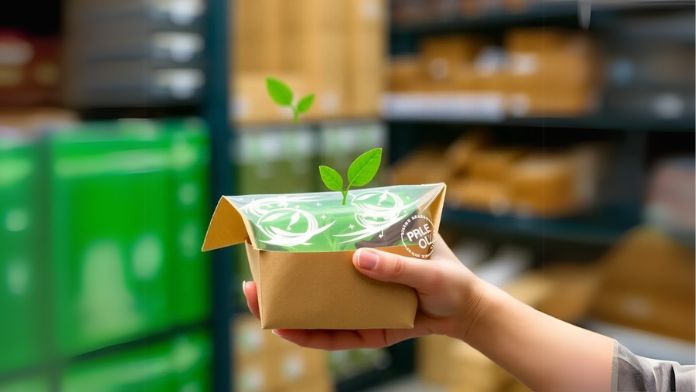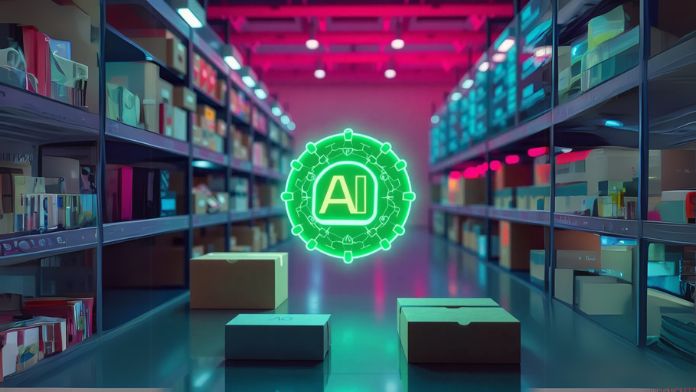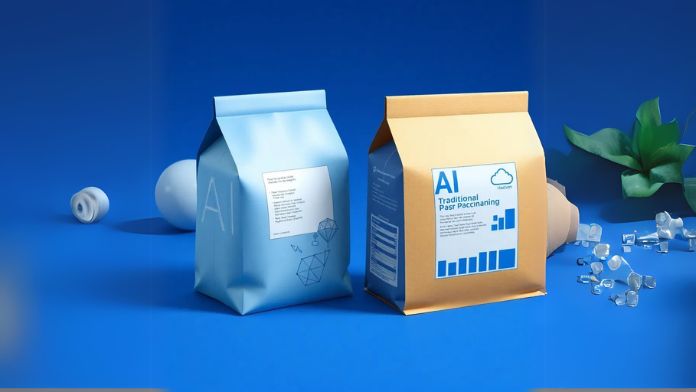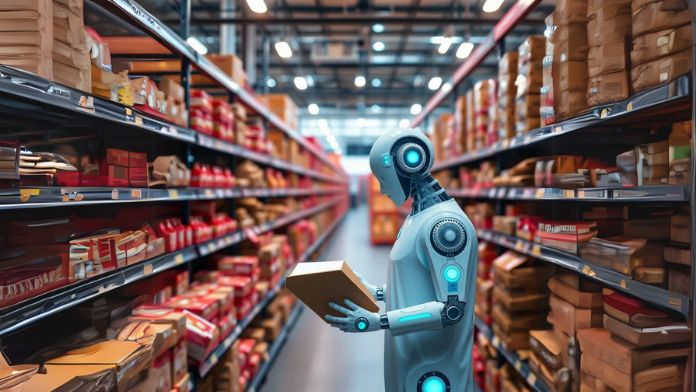In the fast-paced business world, the packaging industry is undergoing a quiet yet profound revolution, all thanks to Artificial Intelligence (AI). From designing eye-catching packages to ensuring sustainability and boosting efficiency, AI is a game-changer. But how exactly is AI reshaping the packaging industry? Let’s dive into the details, explore the innovations, and understand their transformative impact.
The Role of AI in Packaging Design
Streamlining Creativity with AI Packaging Design Generators
AI packaging design generators have become vital for companies looking to create unique, visually appealing, and effective packaging solutions. These advanced tools analyze market trends, customer preferences, and product requirements to deliver design concepts that resonate with target audiences.
For instance, AI-driven platforms can suggest color schemes, typography, and layout ideas based on consumer psychology and industry trends. This saves time and ensures that the designs are optimized for impact. Brands like Coca-Cola and Nestlé have already begun integrating AI in packaging design to maintain their competitive edge.
Enhancing Safety and Efficiency
Reducing Waste Through Predictive Analytics
One of the most exciting applications of AI in food packaging is its ability to minimize waste. AI algorithms analyze data from production, sales, and distribution channels to predict demand accurately. This ensures that companies only produce and package what is necessary, reducing food and material waste.
Smart Packaging for Better Monitoring
AI-powered sensors in food packaging are enhancing safety and quality assurance. These sensors can monitor temperature, humidity, and freshness in real time, ensuring that perishable goods reach consumers optimally. For example, smart labels with AI integration can notify consumers or suppliers if the food has been exposed to unsafe conditions during transit.
The Impact of AI on Sustainability in the Packaging Industry
Designing Eco-Friendly Solutions
Sustainability is at the forefront of modern packaging. AI enables brands to experiment with eco-friendly materials and designs without sacrificing functionality or appeal. By simulating various scenarios, AI tools can suggest materials that are biodegradable, recyclable, or require fewer resources to produce.

Optimizing Packaging Size and Shape
AI helps reduce excess material usage by optimizing the size and shape of packages. This approach minimizes waste and lowers shipping costs by making packages lighter and easier to transport. E-commerce giants like Amazon leverage AI to make their packaging more efficient and sustainable.
Ai Packaging of Market Value: A Booming Trend
Driving Innovation and Growth
The global market value of AI in Packaging industry is growing at an impressive rate. According to recent reports, the sector will exceed billions of dollars in the next few years. This surge can be attributed to the increasing demand for automation, personalization, and sustainability.
Enhancing Supply Chain Management
AI transforms supply chains by predicting market trends and ensuring that packaging processes are agile enough to meet shifting demands. This adaptability boosts profitability and ensures that brands remain relevant in a competitive landscape.’
Personalization of Customer Experiences
AI has a profound effect on consumer experiences. It takes customisation to a whole new level. Innovative materials, sizes, styles, and aesthetics that are suited to personal tastes are all explored in contemporary product package designs.
AI creates packaging solutions with unique textual and visual information for every customer by utilizing consumer data. Product unwrapping may become a distinctive, engaging, and interactive experience with smart packaging that incorporates QR codes and AI-powered sensors. AI makes it possible to envision highly customized packaging that changes color in response to temperature changes or emits pleasant aromas when opened.
The Secret Weapon of AI in Packaging Design
Engaging Customers with Customization
In today’s market, personalization is a key differentiator. AI allows companies to create customized packaging based on consumer data. Whether adding a customer’s name, tailoring a design to regional preferences, or celebrating cultural moments, AI makes it possible to deliver personal and unique packaging.
Augmented Reality and Interactive Packaging
Augmented Reality (AR) is another area where AI reshapes the packaging industry. AR-enabled packaging, powered by AI, creates an interactive experience for consumers. For instance, scanning a QR code on a package could unlock a virtual tour of how the product was made or provide detailed usage instructions.
The Future of AI in Packaging
Expanding Capabilities with Machine Learning
As machine learning algorithms evolve, their applications in the packaging industry will only grow. From improving quality control to developing innovative designs, the possibilities are endless. AI could even predict future packaging trends, enabling brands to stay ahead.

The Integration of Robotics
Robotic arms and AI-powered machinery are becoming increasingly common on production lines. These technologies improve speed, precision, and safety while reducing labor costs. For example, AI-driven robots can accurately sort, label, and assemble packages.
Traditional Packaging vs. AI-Powered Packaging
The packaging industry has seen a significant transformation with the integration of AI technology. To better understand the differences between traditional packaging and AI-powered packaging, here’s a comparison presented in a table format:

| Feature | Traditional Packaging | AI-Powered Packaging |
|---|---|---|
| Design Process | Manual, time-consuming, and reliant on human creativity. | Automated, using AI packaging design generators to create optimized and data-driven designs. |
| Customization | Limited personalization, often requiring manual adjustments. | Highly personalized based on consumer data, enabling dynamic customization. |
| Material Usage | Prone to overuse or underuse of materials. | Optimized material selection and usage through AI simulations and predictions. |
| Sustainability | Eco-friendly solutions are developed manually, requiring extensive research. | AI suggests sustainable materials and minimizes waste with data-driven insights. |
| Efficiency | Slower production processes with room for human error. | Faster and more accurate production lines with AI-powered automation and robotics. |
| Quality Control | Periodic inspections often performed by humans, leading to potential inconsistencies. | Continuous monitoring using AI algorithms, ensuring consistent quality throughout the process. |
| Cost | Higher costs due to inefficiencies and material waste. | Reduced costs through optimization and minimized waste. |
| Supply Chain Management | Reactive management often struggling to adapt to sudden changes. | Proactive, with AI predicting demand and adjusting supply chain processes dynamically. |
| Smart Features | Lacks advanced capabilities like tracking or freshness monitoring. | Smart packaging integrates sensors and AI for real-time tracking and quality assurance. |
| Consumer Engagement | Limited to static visuals and basic branding. | Interactive packaging with features like augmented reality (AR) and QR codes powered by AI. |
| Innovation Speed | Slower, reliant on manual brainstorming and lengthy development cycles. | Faster, with AI identifying trends and providing actionable insights quickly. |
| Market Adaptability | Challenging to pivot or innovate based on rapid market changes. | Agile and adaptive, using AI to forecast trends and adjust strategies. |
Customer Support
Packaging companies deal with business enterprises of all sizes and both B2C and B2B customers. Thus, efficient customer support becomes essential for business growth. For this, the use of AI becomes even more important. AI-driven customer support, such as interactive voice response systems, elevates customer interactions and helps foster lasting brand relationships.
Customers may obtain information on packaging at any time and from any location, thanks to chatbots in particular. Regular problems are fixed quickly, which raises client happiness.
Packaging firms may improve customer satisfaction and obtain important insights into consumer behavior by implementing AI-powered customer care systems. More effective and customized interactions in the packaging sector are made possible by this calculated application of AI.
Challenges and Ethical Considerations
Balancing Automation and Employment
While AI offers numerous benefits, it also raises concerns about job displacement. The packaging industry must find ways to balance automation with employment opportunities, possibly by upskilling workers to handle AI tools.
Data Privacy and Security
AI relies heavily on data to function effectively. Companies must handle consumer data responsibly to maintain trust and comply with privacy regulations.
Companies Face Challenges in Adopting Gen AI
While there is excitement about the potential of gen AI in the paper and packaging industry, respondents cite several challenges that hinder this technology’s quick and seamless adoption (Exhibit 4). The biggest challenges executives report are limited access to data and to a modern tech stack and concerns about how gen AI adoption could raise privacy and IP problems. Respondents also report needing a greater understanding of specific use cases that could drive value from adopting gen AI and express concerns about the associated costs.
Conclusion: A New Era for the Packaging Industry
AI is reshaping the packaging industry in ways that were unimaginable a decade ago. From AI packaging design generators and smart food packaging to sustainability initiatives and personalized consumer experiences, AI’s impact is far-reaching. As the market value of AI in packaging continues to grow, so will the possibilities for innovation and improvement.
The journey is just beginning, and brands that embrace these advancements stand to benefit immensely. Whether you’re a business owner, a designer, or simply a curious consumer, understanding how AI is transforming packaging offers a glimpse into the future of commerce.
By leveraging AI, the packaging industry is keeping pace with technological advancements and setting the stage for a smarter, more sustainable future. It’s exciting to witness how this transformative technology continues to shape our thinking about packaging.
FAQ
Can AI Reshape The Packaging Industry?
In this article, we examine the role AI plays in reshaping the packaging industry and discuss what we can expect to see from it in the future. AI is being applied to practically every process in the packaging industry, rather than being limited to just one area.
How Can AI Improve Packaging Processes?
At the heart of AI’s influence lies the optimization and streamlining of packaging processes. Thanks to AI-driven automation, picture warehouses humming with precision. Previously tedious manual tasks are now completed with ease, which lowers expenses, increases productivity, and guarantees flawless quality standards.
How is AI Affecting Packaging Market Growth?
The increased need for supply chain optimization is one of the main factors propelling the growth of the AI in packaging industry. AI streamlines the entire packaging process, from distribution to sourcing. inventory control. Historical sales data is transformed into a blueprint for exact inventory levels using machine learning techniques.
How Can AI Help Packaging Companies Improve Customer Satisfaction?
As packaging companies implement AI-powered customer support solutions, they enhance customer satisfaction and gain valuable insights into consumer behavior. This strategic use of AI paves the way for more efficient and personalized interactions in the packaging industry.

